
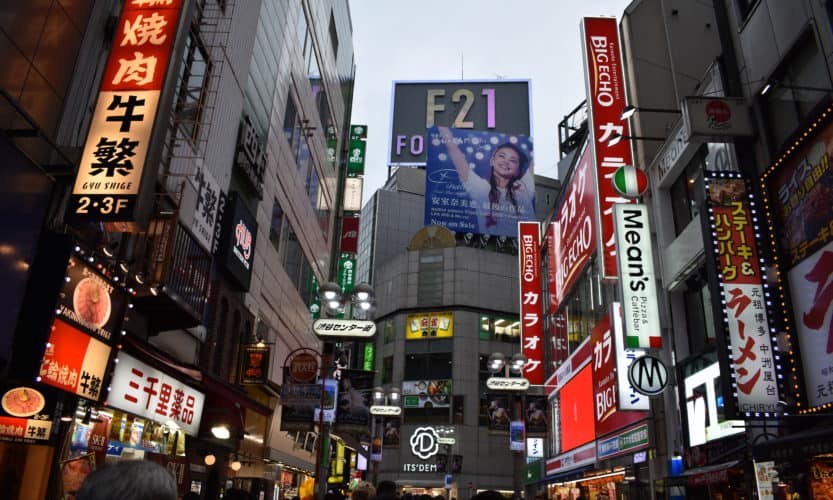
Japan, often known to the outside world as one of the most modern countries in the world, is a country that most people are either ecstatic or indifferent about. Seeing as my dad often had to go to Japan for work and told us stories of his travels, my sister and I were always very excited about visiting the country ourselves one day. In this blog post, I’ll share our reasons for visiting Japan and my ABC of our visit to Japan with you.
Latest update: 2 July 2019
Visiting Japan has been a dream of my sister and I for as long as I can remember. This summer, we finally got to board the airplane bound for Osaka and we lived out our Japanese dreams.
I hear you wonder. “But why Japan? Surely there are other beautiful destinations that are closer by and less expensive to visit?” Well, yes. But we had a few reasons for preferring Japan over any of these destinations.
It might not seem like this, since it’s basically an island at the other side of the world. At least if you’re from Europe. However, flying to Japan was a lot easier than you might expect.
What we did is this:
For a destination that is 9,300 km (5,800 miles) away from home, that seems like a reasonable travel itinerary, right?
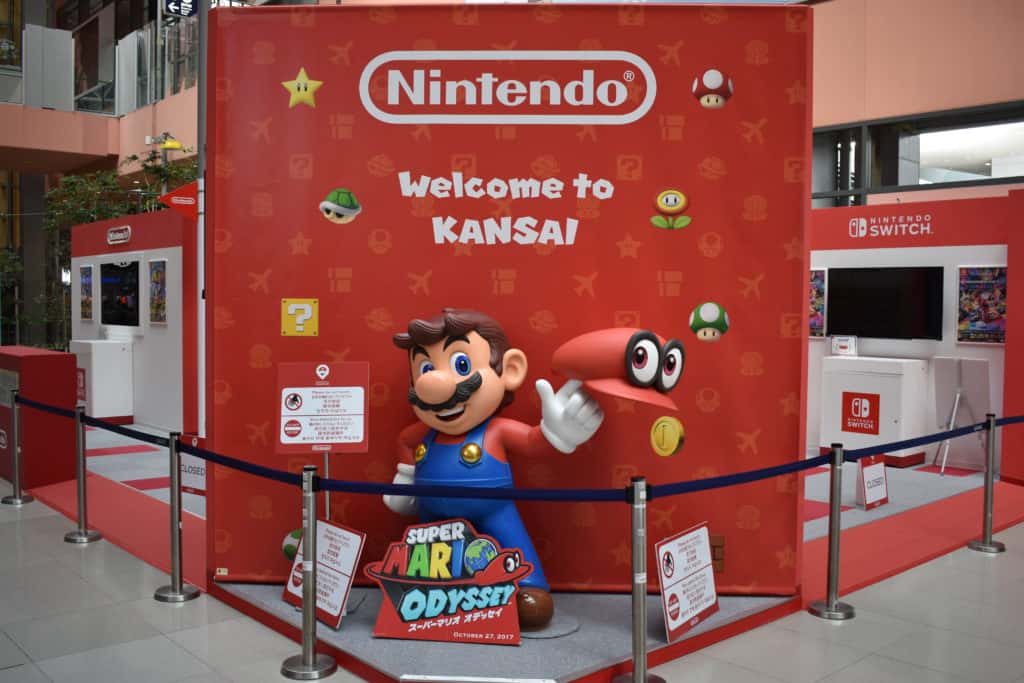
But that’s not the only thing that makes this Asian island an easy destination. You see, my sister and I added another week to our trip. When my parents flew home after our Japan trip, we boarded a flight to Bali.
And although we hadn’t expected to fly another eight hours when we started planning this summer’s holiday, it was extremely easy to get from Japan to Bali. There was a direct flight and we had no problems whatsoever in or around the airport. (We did fail to locate our Wi-Fi device when we arrived in Indonesia, but that’s another story)
Related: How to survive a long-haul flight
At the time of writing this, I’m studying multilingual communication and every single professor tells me something else about the use of the word ‘culture’. It’s being overused, it’s insensitive, it’s a man-made concept that doesn’t really exist, …
You dream it, I’ve had classes about it.
But still: before we started planning this trip, I have always had this idea of Japan as a mythical nation with sumo wrestlers, neon signs, temples and sushi belts.
I’ve always wanted to see whether that image would hold up in reality and how much of it was actually true.
Even when we had just touched down and we were waiting for our bus to the city centre at the airport, there was some kind of culture shock. I know it sounds like a bad thing, but this was more like an ‘I can’t believe we’re here and it’s so different from what I’m used to‘ vibe.
Admittedly, my dad had never gone to Japan for a holiday until we went together as a family. He was always on assignment from the company he works for, and he was always there for business.
Still, though. It was still fascinating to hear him talk about what it’s like to have ramen noodles for breakfast and to be overwhelmed by the number of people in and around the train station, on their way to work. Even just hearing him talk about what it felt like to go to a meeting with Japanese people was eye-opening.
In the twentieth century, Japan was fortunate enough to be the country where an economic miracle took place. After World War 2, the country’s economy was devastated, but it managed to grow tremendously in the period between 1945 and 1990. After this miraculous growth, Japanese demographics stagnated and the workforce dwindled, causing its economic growth to slow down.
The Japanese economy was at one point the second-largest economy in the world, beaten only by the United States. The country is still reaping the benefits of this period, and it’s now globally seen as one of the most technologically advanced countries of the world.
We wanted to see this highly technologised country with our own eyes. And we did.
Admittedly, I wouldn’t have enjoyed about 80% of the food we had in Japan if we had gone on this trip two years earlier. Luckily, we didn’t, and I did end up enjoying most of it.
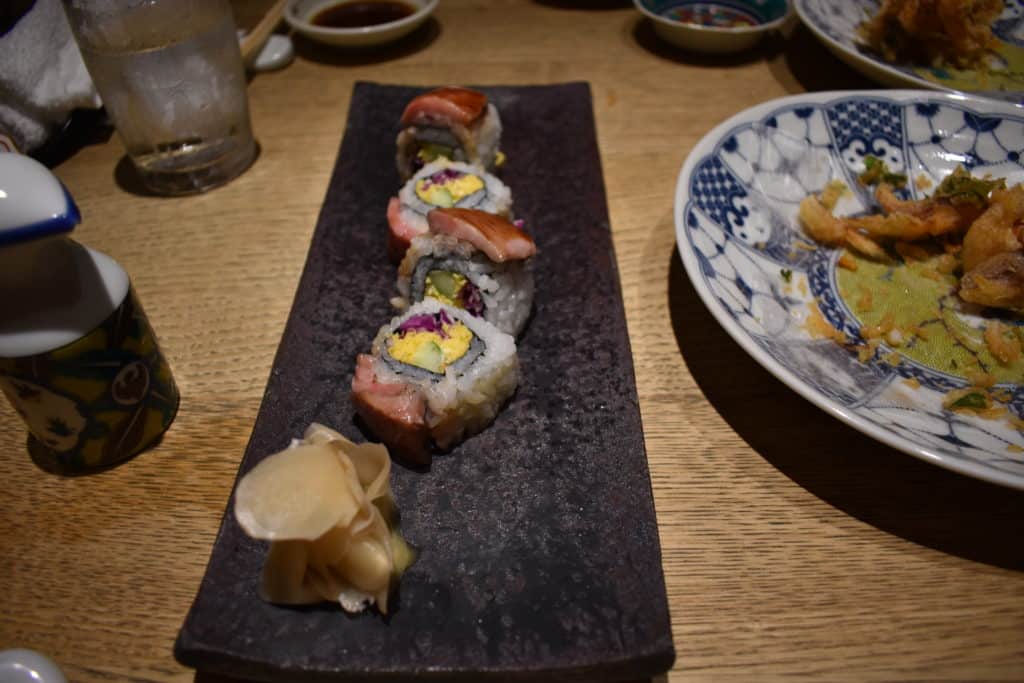
Ramen, takoyaki, sushi and sashimi, okonomiyaki, yakisoba, kakigori, … If you have no idea what I’m talking about, read more about things to know before visiting Japan and look up some pictures of these terms. You’ll want to take the first flight to Japan available.
I feel like Japan is a country that has more prejudices and stereotypes than many other countries. I’m not claiming to be an expert on their personality traits and culture (yes, communication professors, I’m using the word culture again), but I can confirm and debunk *some* of the stereotypes you might have about this country or the people that live in it.
FALSE. Admittedly, sushi is probably the most popular food of Japanese origin in the western world, but Japanese cuisine is much more than just sushi.
A typical Japanese day in terms of meals would look something like this (and yes, I realise I’m oversimplifying this a lot. Don’t sue me please, I’m only trying to convey a message.)
If you have ever experienced a typical Japanese breakfast, lunch or dinner and it’s nothing like this, there’s a comment section below this post begging for you to tell us about it.
Kawaii, as I explain below, is the Japanese concept of cuteness. Anything or anyone that can be considered ‘cute’, such as a stuffed animal, a cartoon drawing or a person, is kawaii in Japan.
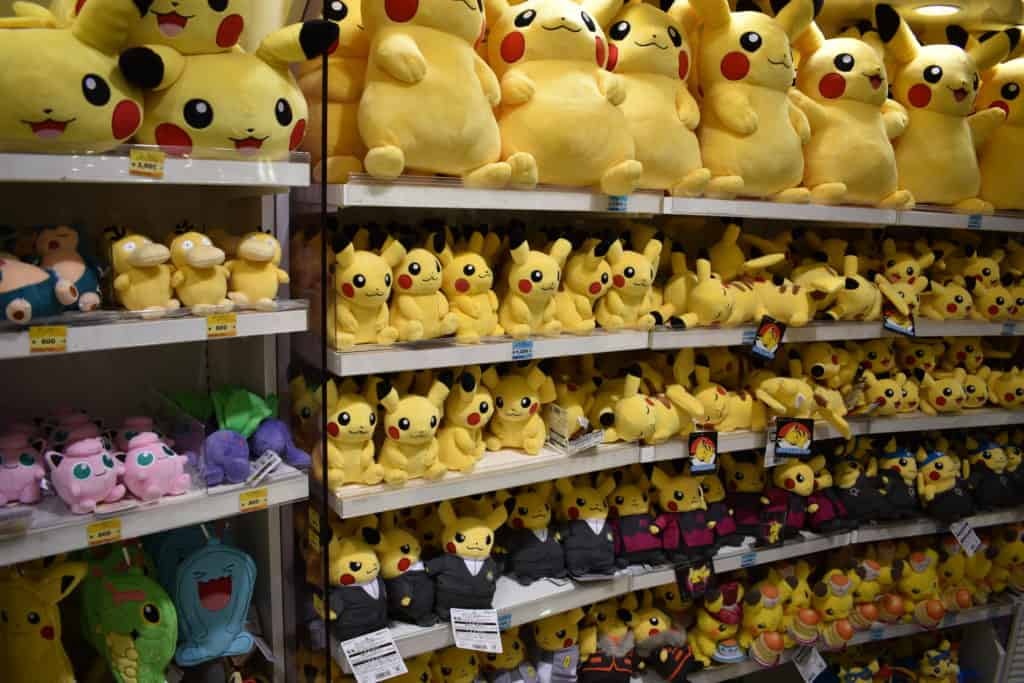
Admittedly, if you spend any time in Japan, you’ll quickly find out that this culture of kawaii is much more present than in any other country on earth. However, I still wouldn’t say Japanese girls are obsessed with kawaii.
More specifically, they’re not OBSESSED with it and it’s not just the girls. Although some critics claim that the concept of kawaii has taken over the country and is now rooted in their culture, I disagree.
Also, not only girls like dressing up and being cute. In Japan, it’s acceptable for anyone to exhibit kawaii behaviour. The feeling among men seems to be split about 50-50 between guys who feel like being called kawaii is a compliment and those who would feel offended.
Okay, yes. This one is probably the most true of all.
It’s hard to judge as a foreigner, because it makes sense for any kind of people, including the Japanese, to be reserved towards foreigners. I’m reserved towards travellers when I’m in Belgium.
But still, I went in with the idea of the polite, kind and reserved Japanese person. And that was confirmed on my trip.
Although recent trends have been emerging that are changing that pattern, many people are consciously making an effort to be nice to others. Some people in Tokyo even set up a project to help the people of Tokyo become even more polite.
Japanese people bow before entering a shrine, they apologise when you run into them, they welcome you when you enter their shops, … The list goes on and on. And yes, these might seem like common courtesy to you, but I’m not used to strangers being polite to me for no apparent reason.
Also true. Then again, what’s weird to you may be normal to someone else. Not trying to judge here, but just listing some things that are less common in most western countries.
Here’s a list of some odd things we noticed in Japan:
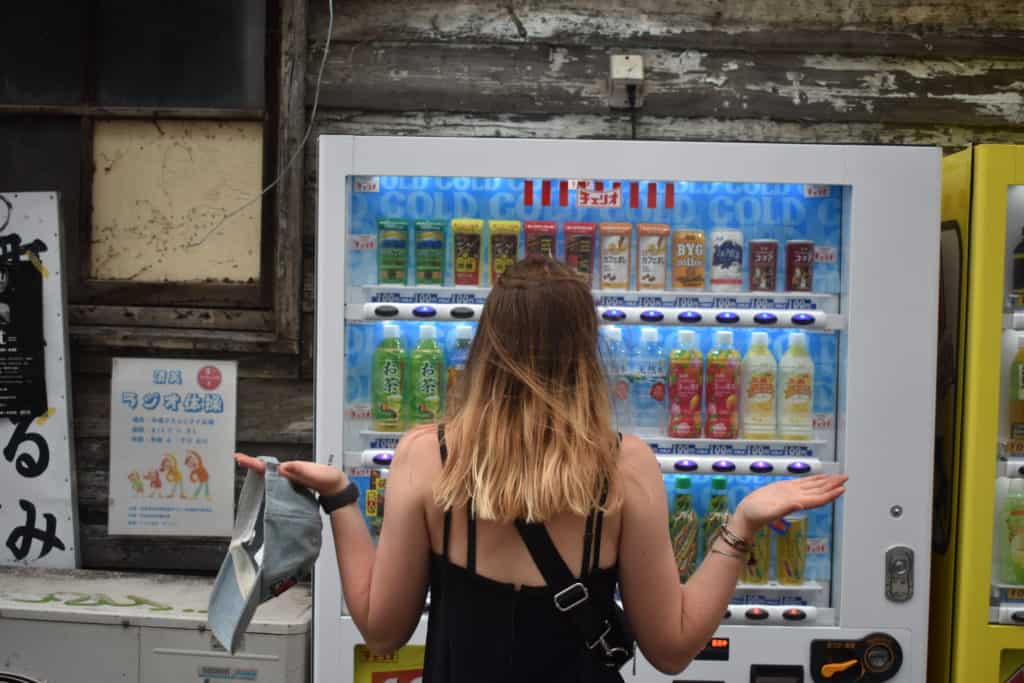
Again, true, and it’s one of the biggest problems Japan is facing nowadays. Their proportion of elderly citizens is among the highest worldwide and that will likely cause the Japanese population to shrink by 30 million in the next 30 years.
Japan is a country with a low fertility rate and a high life expectancy. The large number of old people have a big influence on social policies, such as pensions and long-term healthcare. The Japanese government has started implementing policies to restore the fertility rate and combat the ageing of its population.
Now, for something different entirely. In this last part of the blog post, I’ll try to describe my experience in Japan using the 26 letters of the alphabet, associating each letter with a word or concept that reminds me of what it was like to spend two weeks there.
What better way to start off the ABC of Japan than the Japanese way to say ‘thank you’? During my time in Japan, ‘arigatou gozaimasu’ was essentially the only Japanese expression I felt comfortable saying because it was the only expression I knew.
The religion of Buddhism was introduced to the island in 552 AD by Buddhist monks from Korea. Today, it’s one of the biggest religion in Japan, second only to the traditional Japanese Shinto religion.
The train system in Japan is insane. (See also J is for JR and what you should know before visiting Japan). According to Train-Media, approximately 20 million people commute into Tokyo every single day. Every. Single. Day.
The reason why commuting is so popular in Japan is because rent in big cities is very expensive, and especially in Tokyo prices are insanely high. As a consequence, many people decide to live in the suburbs, where rent is affordable, and commute to work every day.
As one of the most vibrant areas in Osaka, Dotonbori is one of those places that has to be included in your Osaka itinerary.
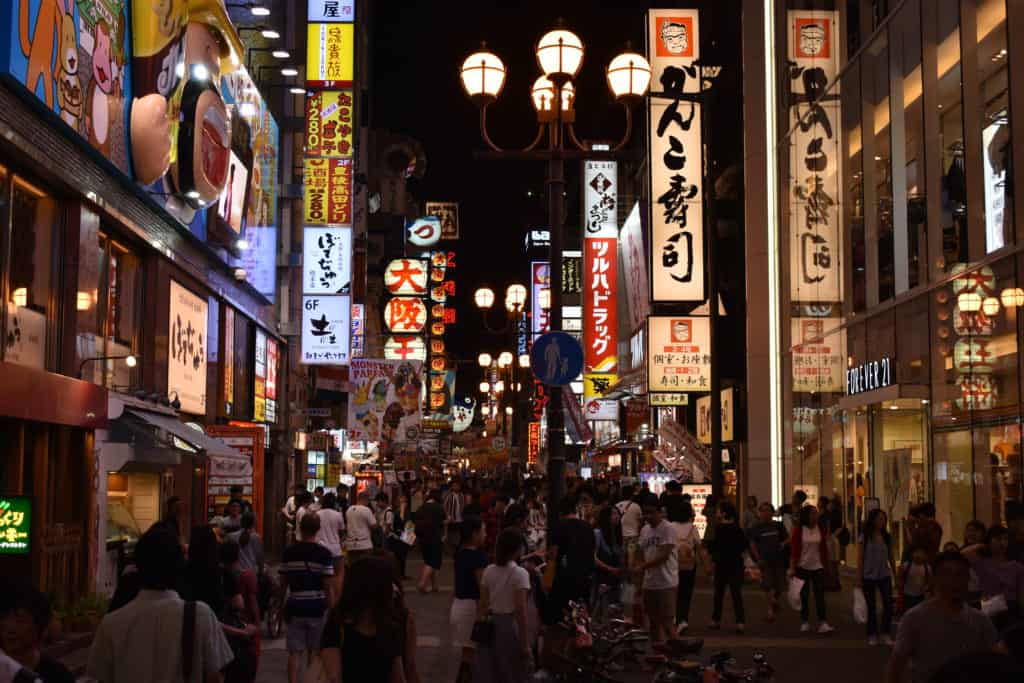
I could literally eat edamame for days. In case you’re unfamiliar, edamame are steamed immature soybeans that are served in the pod, often with salt. In Belgium, we always get a serving of edamame when we get takeout sushi and it’s uh-ma-zing.
It seems like big cities in Japan include department stores like Hankyu, Daimaru and Loft on every street corner. Every department store we visited included a full floor dedicated to food, usually the ground floor and/or the basement. These floors are known as food courts, where you can find all kinds of fresh food.
If you haven’t been to Japan before and you’re imagining what the country is like, chances are geishas are included in that image. Although you might not know the word, you’ll definitely know how they look.
A geisha, literally translated as ‘entertainer’, is a woman who wears traditional costumes and makeup and entertains people (usually men) through performing art, music and dance. Contrary to popular belief in the west, geishas are not prostitutes.
One of the most important concepts in Japanese culture, as you’ll quickly come to realise after spending some time there, is honour. It’s so important to the Japanese that they even have a linguistic system of honorific suffixes to refer to others in conversation.
In Japan, incense is burned at the entrance to every temple. There’s a special Japanese ‘way of incense’ called Kōdō. Similar to a tea ceremony – where incense is also often burned, by the way -, there are specific rules about how to prepare and appreciate incense.
Japan Rail, or JR for short, is the main means of transport on the island. It comprises seven companies that run a network of trains, spanning all the way across the country.
In case you’re wondering how JR trains work – yes, it is quite confusing – check out ‘A quick guide to taking the train in Osaka‘.
Kawaii is the culture of cuteness in Japan. It refers to anything or anyone that can be considered cute or charming. As mentioned above, kawaii is a huge part of Japanese culture and it’s ingrained in most people who live there.
They really do love their lanterns over there. As you can see in this video.
Matcha tea is the central element in traditional Japanese tea ceremonies. Matcha tea is green and has a very specific and peculiar preparation guidelines. Today, matcha is also often used to add flavour to various sweet dishes, such as ice cream, latte and mochi.
Ever wondered why Japanese cities are so big and densely populated? It’s because of nature. A whopping 73% of the country’s area is uninhabitable, which means that almost all Japanese people live on 27% of its landmass.
Of course, that means that the island has an enormous amount of nature for travellers to explore.

Osaka is the third biggest city in Japan. And it’s also a hell of an operating base for day trips due to its central location within the country. Fun fact: Osaka is known among the Japanese as the ‘nation’s kitchen’ for the many delicacies that are produced in the city.
Ahhh, pachinko. Japan’s answer to the gambling ban. Huge pachinko halls can be found in all major cities, usually on dedicated pachinko floors in arcades or as a standalone building.
The point of the game was never really clear to me, but it has something to do with small metal balls that you put into a machine and more metal balls come out. Don’t ask me.
Yes, it was very tough to find a word that started with a Q and had anything to do with Japan. Please just roll with it.
Quail farming industries provide the Japanese with meat and eggs. They’re so popular because the animals grow quickly, are easy to manage and produce eggs at a high rate. The meat serves as a viable protein-rich alternative to chicken.
When I say ramen, I’m not talking about the packets of instant ramen you can buy for 30 cents at Walmart. No, I’m talking about carefully crafted bowls of heaven-sent savoury noodle soup. I had the best bowl of ramen of my life in Tokyo. I’m not exaggerating and I’ll probably never eat ramen that comes close to that one bowl again.
Even if you’ve never heard the name before, you know what Shibuya Crossing looks like. It’s the busiest pedestrian crossing in the world, located in front of Shibuya Station, one of the main commuter hubs of Osaka.
Also: there’s a statue of Hachiko between the crossing and the station and the Starbucks café overlooking the crossing is one of the busiest in the world.
Takoyaki is a very popular street food in Japan, especially in Osaka. It consists of wheat flour-based dough, egg and minced octopus and it’s grilled on a special plate that makes it ball-shaped. I personally don’t love the taste of takoyaki, but I can see why it’s such a popular snack in Japan.
Udon, like ramen, is one of the many popular Japanese noodle varieties. It’s usually served chilled with a soy dipping sauce in the summer or in hot soups and other dishes in the winter. They’re the thickest variety of noodles that is served in Japan.
Japan wouldn’t be Japan without their world-wide image as video game pioneers. Many distinguished game companies, such as Nintendo, Sega, Square Enix and Konami, started in Japan and are still headquartered there.
Today, the fact that video gaming is such a big industry in Japan is reflected in the many enormous entertainment halls, arcades and game centres that can be found in all major cities.
Wasabi is to sushi what peanut butter is to jam. The Japanese usually serve wasabi in the form of a spicy green paste and use it as a condiment in sushi and sashimi dishes. Sushi chefs put the wasabi between the rice and the nori when preparing sushi, in order to preserve its flavour.
Again, X is an incredibly difficult letter to find words for. X-ray fish don’t really have anything to do with Japan, but if you have any suggestions for what to put here, feel free to let me know. Don’t hate me for this please.
Pristella maxillaris, more commonly known as x-ray fish, are a species of fish famous for their translucent body.
Who could have anything against me talking about Japanese food? (Hungry people who like Japanese food, Sander. That’s who.)
Yakisoba is a Japanese noodle stir-fry dish that mainly consists of soba noodles, oyster sauce, pork and vegetables. This was one of the first Japanese dishes I came in contact with as a kid and I loved it right away. I still love it just as much today, if not even more so.
Seems like a nice place to end this blog post. Zen. Do I really need to explain this?
Japan is the country of sushi belts, Shibuya and Starbucks. If you’re still not convinced of the country’s intrinsic value as a tourist destination after reading this, there’s really nothing else I can tell you.
To everyone who made it all the way to the end of this blog post, thank you very much for taking the time to read everything.
What’s your favourite letter in the ABC of Japan? Let me know in a comment!
Thanks for reading!
-S
PIN IT!



Design by NXNW.